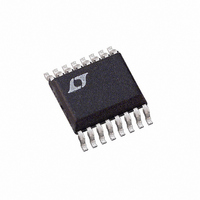LTC1625IGN Linear Technology, LTC1625IGN Datasheet - Page 11

LTC1625IGN
Manufacturer Part Number
LTC1625IGN
Description
IC SW REG STEP-DOWN SYNC 16-SSOP
Manufacturer
Linear Technology
Type
Step-Down (Buck)r
Datasheet
1.LTC1625CSPBF.pdf
(24 pages)
Specifications of LTC1625IGN
Internal Switch(s)
No
Synchronous Rectifier
Yes
Number Of Outputs
1
Voltage - Output
1.19 ~ 36 V
Current - Output
50mA
Frequency - Switching
150kHz
Voltage - Input
3.7 ~ 36 V
Operating Temperature
-40°C ~ 85°C
Mounting Type
Surface Mount
Package / Case
16-SSOP
Lead Free Status / RoHS Status
Contains lead / RoHS non-compliant
Power - Output
-
Available stocks
Company
Part Number
Manufacturer
Quantity
Price
Part Number:
LTC1625IGN
Manufacturer:
LINEAR/凌特
Quantity:
20 000
Part Number:
LTC1625IGN#PBF
Manufacturer:
LINEAR/凌特
Quantity:
20 000
Part Number:
LTC1625IGN#TRPBF
Manufacturer:
LINEAR/凌特
Quantity:
20 000
APPLICATIONS
The corresponding average current depends on the amount
of ripple current. Lower inductor values (higher I
reduce the load current at which Burst Mode operation
begins.
The output voltage ripple can increase during Burst Mode
operation if I
primarily occur when the duty cycle is very close to unity
(V
chosen. This is generally only a concern in applications
with V
causes the inductor current to quickly descend to zero.
However, it takes multiple cycles to ramp the current back
up to I
tor must supply the load current and enough charge may
be lost to cause significant droop in the output voltage. It
is a good idea to keep I
Otherwise, one might need to increase the output capaci-
tance in order to reduce the voltage ripple or else disable
Burst Mode operation by forcing continuous operation
with the FCB pin.
Fault Conditions: Current Limit and Output Shorts
The LTC1625 current comparator can accommodate a
maximum sense voltage of 150mV. This voltage and the
sense resistance determine the maximum allowed peak
inductor current. The corresponding output current limit
is:
The current limit value should be checked to ensure that
I
generally occurs with the largest V
ent temperature, conditions which cause the highest power
dissipation in the top MOSFET. Note that it is important to
check for self-consistency between the assumed junction
temperature of the top MOSFET and the resulting value of
I
Caution should be used when setting the current limit
based upon R
current limit is determined by the minimum MOSFET on-
resistance. Data sheets typically specify nominal and
LIMIT(MIN)
LIMIT
IN
I
LIMIT
is close to V
which heats the junction.
BURST(PEAK)
OUT
> I
R
O(MAX)
DS ON
L
5V. At high duty cycles, a skipped cycle
150
DS(ON)
is substantially less than I
(
OUT
. During this interval, the output capaci-
mV
U
)
. The minimum value of current limit
) or if very large value inductors are
of the MOSFETs. The maximum
T
INFORMATION
U
L
–
comparable to I
2
1
I
L
IN
W
at the highest ambi-
BURST
BURST(PEAK)
U
. This will
L
) will
.
maximum values for R
reasonable, but perhaps overly conservative, assumption
is that the minimum R
the typical value as the maximum R
Consult the MOSFET manufacturer for further guidelines.
The LTC1625 includes current foldback to help further
limit load current when the output is shorted to ground. If
the output falls by more than half, then the maximum
sense voltage is progressively lowered from 150mV to
30mV. Under short-circuit conditions with very low duty
cycle, the LTC1625 will begin skipping cycles in order to
limit the short-circuit current. In this situation the bottom
MOSFET R
rather than the top MOSFET controlling the inductor
current peak. The short-circuit ripple current is deter-
mined by the minimum on-time t
(approximately 0.5 s), the input voltage, and inductor
value:
The resulting short-circuit current is:
Normally, the top and bottom MOSFETs will be of the same
type. A bottom MOSFET with lower R
may be chosen if the resulting increase in short-circuit
current is tolerable. However, the bottom MOSFET should
never be chosen to have a higher nominal R
top MOSFET.
Inductor Core Selection
Once the value for L is known, the type of inductor must be
selected. High efficiency converters generally cannot
afford the core loss found in low cost powdered iron cores,
forcing the use of more expensive ferrite, molypermalloy
or Kool M
size for a fixed inductor value, but it is very dependent on
the inductance selected. As inductance increases, core
losses go down. Unfortunately, increased inductance
requires more turns of wire and therefore copper losses
will increase.
Kool M is a registered trademark of Magnetics, Inc.
I
SC
I
L(SC)
R
= t
®
DS(ON)
DS ON BOT
cores. Actual core loss is independent of core
ON(MIN)
(
30
)(
will control the inductor current trough
mV
V
DS(ON)
IN
)
/L.
DS(ON)
T
lies the same amount below
, but not a minimum. A
2
1
ON(MIN)
I
DS(ON)
L SC
DS(ON)
(
LTC1625
)
of the LTC1625
DS(ON)
lies above it.
than the top
than the
11














